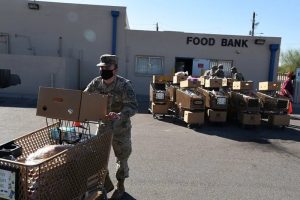Annotated Student Sample: Research Log
Introduction
Living by Their Own Words
Planning to Write

Freewrite: I found this photograph in an article I was reading about food insecurity during the COVID-19 pandemic. I copied and pasted it here as inspiration for my argumentative research paper.
Lily Tran includes a visual in the freewrite section of her research log. The visual may or may not appear in the final paper, but here, it serves to stimulate her writing and thinking about her topic and possibly connect to other information she finds.
For a sustainable future, food production and processing have to change. So does global distribution.
Tran begins to establish problem-and-solution reasoning, recognizing that there are different stages to food production and that all will be affected by any proposed solution.
The necessary changes will affect nearly all aspects of life, including world hunger, health and welfare, use of land resources, habitats, water, energy use and production, greenhouse gas emissions and climate change, and economics, as well as cultural and social values.
Tran also employs cause-and-effect reasoning in beginning to think about the effects of any proposed change.
These needed changes may not be popular, but people will have to accept them.
She recognizes potential counterarguments to address if the paper is to be persuasive.
| Information | Connection to Thesis/Main Points | Notes/Cross-References/Synthesis |
|---|---|---|
| Date: 12/07/2020
Their report states, “If society continues on a ‘business-as-usual’ dietary trajectory, a 119% increase in edible crops grown will be required by 2050” (Berners-Lee et al., 2018, p. 1). |
Shows why a solution to food sustainability is needed | Create a concrete example to support this statistic. For example, if Farmer Joe grows . . .
Tie to the explanation of the problem for which I’m proposing a solution. |
| Tran cites and quotes an alarming statistic from a secondary source. | She makes a connection to her thesis. | She anticipates that not all readers will respond to the statistic alone. To counteract this possibility, she may decide to create an original anecdotal example.
Tran then connects the information to the text structure: problem/solution. |
|
Source/Citation: Berners-Lee, M., Kennelly, C., Watson, R., & Hewitt, C. N. ( 2018). Current global food production is sufficient to meet human nutritional needs in 2050 provided there is radical societal adaptation.” Elementa: Science of the Anthropocene, 6(52), 1-14. https://doi.org/10.1525/elementa.310 Tran uses APA 7th edition style guidelines to create this citation for her log entry. She includes all information needed for citing the entry in the works cited list for her paper. |
||
Discussion Questions
- If Lily Tran were to use the photo, what information or questions might she enter in the right-hand column of her research log?
- Why do you think Tran has chosen a direct quotation instead of a summary or paraphrase?
-
Why is the information in the center column important to include in a research log?
Attribution & References
Except where otherwise noted, this section is adapted from “13.4 Annotated Student Sample: Research Log” In Writing Guide with Handbook (OpenStax) by Michelle Bachelor Robinson, Maria Jerskey and featuring Toby Fulwiler, licensed under CC BY 4.0. Access for free at Writing Guide with Handbook (OpenStax)
Reference
Berners-Lee, M., Kennelly, C., Watson, R., & Hewitt, C. N. (2018). Current global food production is sufficient to meet human nutritional needs in 2050 provided there is radical societal adaptation.” Elementa: Science of the Anthropocene, 6(52), 1-14. https://doi.org/10.1525/elementa.310

